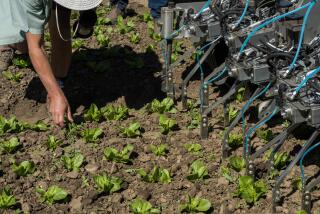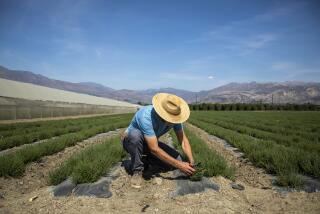One Word for the Future of Farming? Plastics
- Share via
PARLIER, Calif. — Walk along a small plot of tomatoes at University of California Kearney Agricultural Center and it’s easy to spot which ones were planted in a silver-colored plastic mulch system.
Those tomato bushes are noticeably bigger and have more green fruits hanging on the vines than those planted on bare soil.
The plastic mulch system is nothing fancy, just a long plastic sheet that covers the rows where the tomatoes are planted.
The idea of using plastic to cover the ground has been around for a while, but the use of silver-colored plastic that reflects sunlight is relatively new.
In areas where temperatures dip very low, growers have used black plastic mulch to keep the soil warm during the night. The mulch also helps prevent soil erosion while keeping the ground moist longer with less water evaporating during the day.
The silver-colored reflective plastic mulch helps the crops and the soil in similar ways, but adds another one-two punch.
“Silver mulch increases more light to the plant canopy,” UC integrated pest management plant pathologist Jim Stapleton said. “That basically translates into more photosynthesis and increased growth of the plant.”
The plastic also reflects ultraviolet light, which repels insects like the aphids that carry devastating diseases.
“If the insects can’t land, they can’t transmit diseases,” said UC entomologist Charlie Summers. “Many of these diseases are transmitted in seconds. That’s why a lot of insecticides don’t work against them.”
Although further tests are scheduled, the preliminary results from other vegetables are promising.
With pumpkins, the researchers found virtually no silverleaf whitefly infestation on a plot with the reflective plastic after a week of planting. On bare ground, nearly 40% of the crop was infected in the same period. After three weeks, less than 1% was infected in the reflective system, while nearly 70% was infected on crops planted in the bare ground.
Similar results were found with cucumbers, zucchinis, squash, cantaloupes, eggplants, broccoli and sweet corn.
Take into consideration the decrease in the amount of crops lost through diseases and increase in production due to better photosynthesis. The researchers found yields in cucumbers went up tenfold: six pounds per plot versus 60 pounds per plot.
“It works real good. I’m not sure why more people don’t do it,” said Mike Satterstrom, a pumpkin farmer who agreed to participate in the UC research two years ago. “What we’ve seen is that the leaf of the plant gets 50% to 60% bigger. The leaves are stronger, . . . increasing the vitality of the plant.”
Satterstrom, 49, has seen his yields leap by more than 50%.
“It’s partly because you don’t have the bug problem anymore,” Satterstrom said. “We don’t use much in the way of pesticides anymore.”
There are several other growers around the San Joaquin Valley who are using the reflective plastic and their number is growing, said Andy Cabrera, manager of Specialty Ag Equipment, which sells the plastic in 2,000-foot rolls.
The 5-year-old company in its first year sold about 3,000 rolls, but now its clientele has gone international, selling more than 300,000 rolls a year in California, Oregon, Washington, Michigan, New York, Spain and Chile.
The growers “were really skeptical at first,” Cabrera said. “But you know how the farmers are. They talk to each other.”






